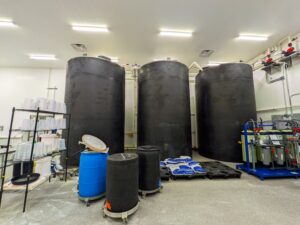Lean Farming: Extra-Processing

Tackling Extra-Processing for Better Efficiency
Lean farming aims to reduce waste and improve productivity. One major form of waste is extra-processing. This happens when growers do more than necessary to meet specifications. Often, unclear standards or poor training cause this. Low confidence in system controls also plays a role. Extra-processing creates unnecessary steps in daily operations. These steps consume time, labor, and resources.
Overwatering
For example, overwatering crops is common. Growers may think more water means healthier plants. In reality, it can lead to root rot and disease. Over-watering cannabis plants causes several problems that reduce overall health and yield. First, excess water suffocates roots by limiting oxygen access. Then, root rot and fungal diseases may develop, weakening the plant. As growth slows, leaves may yellow or droop, signaling stress.
Over-watering can wash away nutrients, forcing growers to add more. This creates waste and increases costs. To avoid these issues, monitor soil moisture and adjust watering based on plant needs. It is necessary to train staff to recognize signs of proper hydration. In lean farming, every drop should serve a purpose!
Excess Feeding
Using too many nutrients in cannabis cultivation often leads to extra-processing. First, growers may assume more nutrients boost growth. However, excess feeding can harm root systems and soil health. Feeding plants too many nutrients can backfire. Excess nutrients may harm soil health and reduce yield. As a result, plants show stress instead of improvement. When growers add more inputs to fix the damage, it creates a vicious cycle that can damage and kill your crop.
To prevent this, define clear feeding limits based on plant stage. Train staff to recognize signs of overfeeding. Use data to guide nutrient schedules. Finally, remind teams that more isn’t always better. With clear standards and confidence in controls, growers avoid waste and protect plant health.
Leaf Maintenance
Over-pruning, or defoliation, is another issue. While pruning helps growth, too much weakens the plant. It also increases labor costs. Removing too many leaves stresses the plant. This action often stems from a “more is better” mindset. But in lean farming, more isn’t always better!
Extra pruning in cannabis cultivation often results from the belief that more leaf removal improves airflow and light penetration. However, removing too many leaves stresses the plant and disrupts its natural growth rhythm. This stress reduces photosynthesis, which is vital for energy production and healthy development. As growth slows, teams may mistakenly defoliate even more, thinking it will help. Instead, this creates a cycle of overcorrection and inefficiency. To break this pattern, growers must set clear defoliation limits based on plant stage and canopy density. Training staff to recognize when enough is enough helps prevent waste. In lean farming, precision matters.
So how do we define “done”?
This question is key to avoiding extra-processing. Clear standards help workers know when a task is complete. Without them, they may keep working past the point of value.
Solutions to Extra-Processing in Cannabis Facilities
- Define “Done” Clearly
Create visual standards and SOPs that show what a finished task looks like. Avoid vague expectations. - Train Staff Thoroughly
Provide hands-on training with clear examples. Reinforce confidence in tools, systems, and decision-making. - Use Checklists and Visual Aids
Post simple guides near workstations to prevent overwatering, over-pruning, or extra defoliation. - Standardize Nutrient Feeding Schedules
Base feeding on plant stage and data, not guesswork. Avoid “just in case” applications. - Monitor and Adjust Watering Practices
Use soil moisture sensors or timers. Teach staff that more water doesn’t mean better growth. - Limit Pruning to What’s Necessary
Set pruning thresholds by plant type and growth phase. Track results to refine guidelines. - Reduce Defoliation Frequency
Only remove leaves when they block light or airflow. Avoid cosmetic defoliation. - Empower Staff to Ask Questions
Encourage a culture where workers ask “Is this step necessary?” before acting. - Audit Tasks Regularly
Review daily routines to identify and eliminate non-value-adding steps. - Use Lean Metrics
Track labor hours, input use, and yield. Use data to spot inefficiencies. - Remind Staff Often
Reinforce lean principles in meetings and signage. Keep “more isn’t always better” top of mind. - Create Feedback Loops
Let staff report unclear standards or redundant steps. Improve processes based on their input.
In the end, lean farming is about smart choices. It’s about trusting the process and avoiding excess. With clear standards and good training, farms thrive. Let’s remember: more can harm instead of help and smart limits lead to better results.